Clam Toxin Resistance
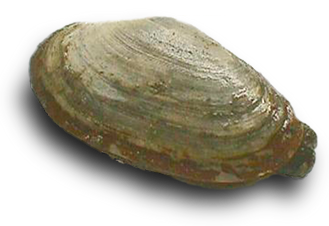
Soft shell clams (Mya arenaria) are bivalves native to the east coast of North America. They have become invasive species elsewhere throughout the northern hemisphere, inhabiting brackish waters, estuaries and marine environments.
Soft shell clams are susceptible to toxins that are associated with certain algal bloom events. These events are characterized by an upwelling of dinoflagellates, microscopic algal protists that naturally produce toxins harmful to marine organisms. Clams that are not resistant to the toxin often die. However, toxin resistance can occur if there is a mutation in the clam’s voltage gated sodium channel gene.
This case examines the evolution of toxin resistance in clams.
Ecology
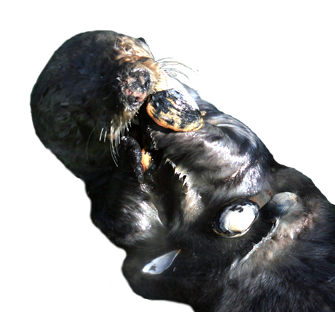 Soft shell clams (Mya arenaria) are bivalves native to the east coast of North America. Some populations of the clams have individuals living in them who are resistant to a toxin called saxitoxin, while others do not. To understand how saxitoxin gets into the soft shell clams and where it goes from there we need to examine the clams as part of a marine food web.
Soft shell clams (Mya arenaria) are bivalves native to the east coast of North America. Some populations of the clams have individuals living in them who are resistant to a toxin called saxitoxin, while others do not. To understand how saxitoxin gets into the soft shell clams and where it goes from there we need to examine the clams as part of a marine food web.
The Source of Saxitoxin
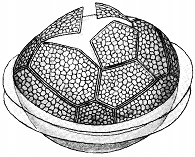 Soft shell clams are filter feeders. They feed by filtering water through their gills and consuming particulate matter that is entrapped. During algal blooms, soft shell clams consume large quantities of microscopic dinoflagellate algal protists. These protists (Alexandrium spp.) naturally produce a paralytic shellfish toxin, saxitoxin.
Soft shell clams are filter feeders. They feed by filtering water through their gills and consuming particulate matter that is entrapped. During algal blooms, soft shell clams consume large quantities of microscopic dinoflagellate algal protists. These protists (Alexandrium spp.) naturally produce a paralytic shellfish toxin, saxitoxin.
Algal blooms, also known as red tide, occur during warm summer months when nutrient conditions and water temperature stimulate dinoflagellate reproduction. High concentrations of dinoflagellates produced during algal blooms leads to high exposure of soft shell clams to saxitoxin.
Selection Pressure and Biomagnification of Saxitoxin
On the Atlantic coast of North America it appears as though algal blooms act as an agent of natural selection, reducing the fitness of (or killing) soft shell clams that are not resistant to saxitoxins. Those that are resistant to the toxin begin to accumulate it as they filter feed.
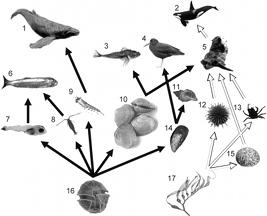 Humans and other animals at higher trophic levels such as gulls, green crabs, moon snails, otters, and sturgeon can be poisoned by saxitoxin when they eat resistant clams during or after algal bloom events. When clams are not resistant to the toxin, they often die, giving humans and other would-be predators an indication that they are not safe to consume. However, when clams are resistant they can accumulate the toxin without giving any indication that they are unsafe to eat. These concentrations of saxitoxin in resistant clams are small when compared to the body mass of would-be predators. However, predators can ingest large quantities of the toxin, resulting in biomagnification of the toxin level. For example, if a fish feeds on many toxic clams and a human feeds on many toxic fish, the total amount of saxitoxin consumed by a given human can end up being equivalent to the total toxin present in the dozens or hundreds of clams originally consumed by the fish.
Humans and other animals at higher trophic levels such as gulls, green crabs, moon snails, otters, and sturgeon can be poisoned by saxitoxin when they eat resistant clams during or after algal bloom events. When clams are not resistant to the toxin, they often die, giving humans and other would-be predators an indication that they are not safe to consume. However, when clams are resistant they can accumulate the toxin without giving any indication that they are unsafe to eat. These concentrations of saxitoxin in resistant clams are small when compared to the body mass of would-be predators. However, predators can ingest large quantities of the toxin, resulting in biomagnification of the toxin level. For example, if a fish feeds on many toxic clams and a human feeds on many toxic fish, the total amount of saxitoxin consumed by a given human can end up being equivalent to the total toxin present in the dozens or hundreds of clams originally consumed by the fish.
On the west coast of North America a closely related bivalve, the butter clam (Saxidomus gigantean), is also resistant to paralytic shellfish toxins and some scientists suggest that the clams sequester it for use as a defense against sea otter predation. An increasing frequency of algal blooms (possibly due to global warming: Paul, 2008) has resulted in increasingly toxic butter clam populations. It is possible that this increase in toxicity has hindered a natural re-expansion of sea otters into the southern part of its historical range where algal blooms are now more common (Kvitek and Bretz, 2004).
Cell Biology
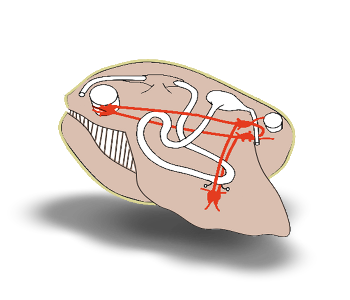 Soft shell clams (Mya arenaria) are bivalves native to the east coast of North America. Some individual clams are resistant to a harmful neurotoxin called saxitoxin while others are not. Saxitoxin affects the function of the neurons and can result in paralysis and/or death in clams and in organisms that eat toxic clams. Neurons are affected because the toxin blocks voltage gated sodium channels along nerve axons preventing nerve signal transmission to the axon terminus.
Soft shell clams (Mya arenaria) are bivalves native to the east coast of North America. Some individual clams are resistant to a harmful neurotoxin called saxitoxin while others are not. Saxitoxin affects the function of the neurons and can result in paralysis and/or death in clams and in organisms that eat toxic clams. Neurons are affected because the toxin blocks voltage gated sodium channels along nerve axons preventing nerve signal transmission to the axon terminus.
Neurons and Action Potential
 Neurons (nerve cells) are responsible for receiving, conducting, and sending electrochemical signals throughout the body of an organism. Collectively, neurons comprise an organism’s nervous system. A neuron passes current (action potential) down its length due to electrochemical events mediated by voltage gated sodium channels, voltage gated potassium channels and sodium-potassium pumps situated in the membrane along the length of the axon.
Neurons (nerve cells) are responsible for receiving, conducting, and sending electrochemical signals throughout the body of an organism. Collectively, neurons comprise an organism’s nervous system. A neuron passes current (action potential) down its length due to electrochemical events mediated by voltage gated sodium channels, voltage gated potassium channels and sodium-potassium pumps situated in the membrane along the length of the axon.
The voltage gated sodium channel is an intra-membrane protein that facilitates the movement of sodium ions across the cell membrane on the axon. As these channels open and close down the length of the axon, the action potential travels from the cell body to the neuron axon terminal. More information on action potential
Saxitoxin and Neurons
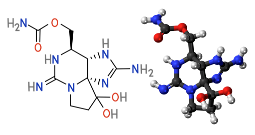 The voltage-gated sodium channel has two gates, an extracellular activation gate that opens the channel and an intracellular inactivation gate that closes the channel. The neurotoxin saxitoxin disrupts sodium channel function by (reversibly) binding to the activation gate and preventing it from opening. This means that sodium diffusion into the axon cannot occur. Axons can only transmit nerve signals by virtue of their ability to change voltage differential along their length. If sodium ions cannot diffuse across the axon membrane, the voltage differential between intra- and extra-cellular spaces cannot change and the neuron cannot conduct a nerve signal. When this happens to many neurons, the entire nervous system can be disabled resulting in paralysis and/or death.
The voltage-gated sodium channel has two gates, an extracellular activation gate that opens the channel and an intracellular inactivation gate that closes the channel. The neurotoxin saxitoxin disrupts sodium channel function by (reversibly) binding to the activation gate and preventing it from opening. This means that sodium diffusion into the axon cannot occur. Axons can only transmit nerve signals by virtue of their ability to change voltage differential along their length. If sodium ions cannot diffuse across the axon membrane, the voltage differential between intra- and extra-cellular spaces cannot change and the neuron cannot conduct a nerve signal. When this happens to many neurons, the entire nervous system can be disabled resulting in paralysis and/or death.
Resistance to Saxitoxin
Some clams are resistant to saxitoxin poisoning. A mutation in the gene encoding the voltage gated sodium channel protein prevents the toxin from binding to the channel gate. If saxitoxin cannot bind to the sodium channel it has no effect in the clam. However, the toxin is not neutralized. It resides in the body and can still harm other organisms that might eat the clam.
Molecular Genetics
 Soft shell clams (Mya arenaria) are bivalves native to the east coast of North America. Some individual clams are resistant to a harmful neurotoxin called saxitoxin while others are not. Resistance results from a mutation in the gene encoding a voltage gated sodium channel, a transmembrane protein in the axon of neuron cells. Neurons are affected by saxitoxin because the toxin blocks voltage gated sodium channels along nerve axons preventing nerve signals from being transmitted from the dendrite to the axon terminus.
Soft shell clams (Mya arenaria) are bivalves native to the east coast of North America. Some individual clams are resistant to a harmful neurotoxin called saxitoxin while others are not. Resistance results from a mutation in the gene encoding a voltage gated sodium channel, a transmembrane protein in the axon of neuron cells. Neurons are affected by saxitoxin because the toxin blocks voltage gated sodium channels along nerve axons preventing nerve signals from being transmitted from the dendrite to the axon terminus.
DNA, Central Dogma, and the Voltage Gated Sodium Channel
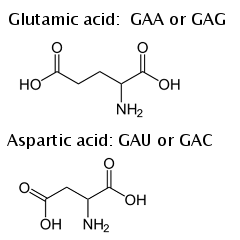 DNA is made up of long strings of nucleotides. There are four nucleotides in DNA: Adenine (A), Thymine (T), Guanine (G) and Cytosine (C). These nucleotides are held together by a phosphate-sugar “backbone” and are complemented by a parallel strand of nucleotides making a DNA molecule “double-stranded”. Parallel strands are held together by hydrogen bonds between bases; Adenine binds to Thymine, Cytosine binds to Guanine. Discrete sections of DNA carry sequences of nucleotides that, when processed, are responsible for proteins or functional RNA chains. These sections are called genes. When making a protein, the DNA is first transcribed into a single-stranded piece of messenger RNA (mRNA) using an enzyme called RNA polymerase. The newly made mRNA is then translated through a ribosome into a long chain of amino acids. This chain of amino acids folds up to make a functional protein. Proteins build the organism, including all measurable and observable characteristics.
DNA is made up of long strings of nucleotides. There are four nucleotides in DNA: Adenine (A), Thymine (T), Guanine (G) and Cytosine (C). These nucleotides are held together by a phosphate-sugar “backbone” and are complemented by a parallel strand of nucleotides making a DNA molecule “double-stranded”. Parallel strands are held together by hydrogen bonds between bases; Adenine binds to Thymine, Cytosine binds to Guanine. Discrete sections of DNA carry sequences of nucleotides that, when processed, are responsible for proteins or functional RNA chains. These sections are called genes. When making a protein, the DNA is first transcribed into a single-stranded piece of messenger RNA (mRNA) using an enzyme called RNA polymerase. The newly made mRNA is then translated through a ribosome into a long chain of amino acids. This chain of amino acids folds up to make a functional protein. Proteins build the organism, including all measurable and observable characteristics.
Substitution Mutation
There are two alleles for the gene that codes for the voltage gated sodium channel protein in soft shell clams: E and D. In clams sensitive to saxitoxin paralysis, the amino acid at position 632 in the sodium channel protein is a glutamic acid (E). However, in clams resistant to saxitoxin paralysis, the amino acid at position 632 in the sodium channel protein is aspartic acid (D) [note: this numbering is based on partial gene sequence of the sodium channel]. The nucleotide codon that results in a glutamic acid can be either GAA or GAG whereas the nucleotide codon that results in aspartic acid can be either GAT or GAC. This means that saxitoxin resistance in soft shell clams can be attributed to one single nucleotide substitution mutation. Functionally, aspartic acid is shorter than glutamic acid by one methylene group. The presence or absence of this one methylene group is the difference between being able to bind saxitoxin or not, and hence whether or not the clam is sensitive or resistant to saxitoxin..
Mutation and the Activation Gate
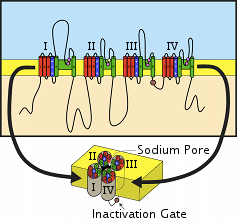 The voltage gated sodium channel protein has four transmembrane domains with six subdomains in each. The space between subdomains 5 and 6 form a pore that allows sodium passage through the membrane into the axon. The extracellular loops between subdomains 5 and 6 form the activation gate. When the polarity of the cell becomes negative, the voltage gated sodium channel changes shape (conformation) conformation causing the extracellular gate to open. Some of the amino acid residues in the extra-cellular loops between these subdomains form active sites that allow for saxitoxin binding. The mutation and subsequent change from glutamic acid to aspartic acid at amino acid position #632 in the sodium channel protein changes the physical properties of one of the binding sites located in domain II, between sub-domains 5 and 6. This changes the binding affinity for the entire pore making the clam resistant to saxitoxin.
The voltage gated sodium channel protein has four transmembrane domains with six subdomains in each. The space between subdomains 5 and 6 form a pore that allows sodium passage through the membrane into the axon. The extracellular loops between subdomains 5 and 6 form the activation gate. When the polarity of the cell becomes negative, the voltage gated sodium channel changes shape (conformation) conformation causing the extracellular gate to open. Some of the amino acid residues in the extra-cellular loops between these subdomains form active sites that allow for saxitoxin binding. The mutation and subsequent change from glutamic acid to aspartic acid at amino acid position #632 in the sodium channel protein changes the physical properties of one of the binding sites located in domain II, between sub-domains 5 and 6. This changes the binding affinity for the entire pore making the clam resistant to saxitoxin.
Population Genetics
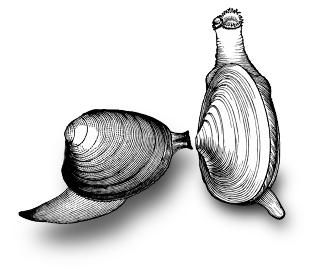 Soft shell clams (Mya arenaria) are bivalves native to the east coast of North America. Some individual clams are resistant to a harmful neurotoxin called saxitoxin while others are not. During algal bloom events, soft shell clams ingest quantities of dinoflagellates that produce saxitoxin. If a clam is resistant, it will eat dinoflagellates and be unaffected by the saxitoxin. If a clam is not resistant, it will often succumb to the effects of saxitoxin poisoning resulting in paralysis or death.
Soft shell clams (Mya arenaria) are bivalves native to the east coast of North America. Some individual clams are resistant to a harmful neurotoxin called saxitoxin while others are not. During algal bloom events, soft shell clams ingest quantities of dinoflagellates that produce saxitoxin. If a clam is resistant, it will eat dinoflagellates and be unaffected by the saxitoxin. If a clam is not resistant, it will often succumb to the effects of saxitoxin poisoning resulting in paralysis or death.
Distribution of Saxitoxin Resistance
The distribution of resistant clams is not random among populations. Resistance is more common among populations in the native (east coast) range that have a history of being exposed to algal bloom events (Connell et al, 2007). The images below show the proportion of clams in a set of populations found to be sensitive to saxitoxin (sensitivity represented in black and resistance in white; image taken from Connell et al., 2007).
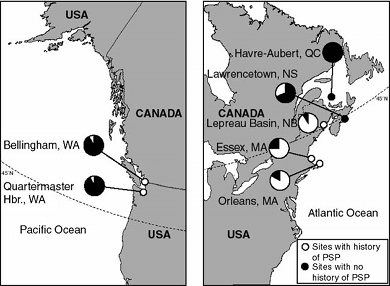
In the North American populations the proportion of clams resistant to the toxin was smaller at higher latitudes where water temperatures were cooler and bloom occurrence was rare.
